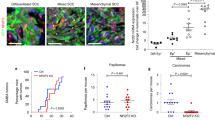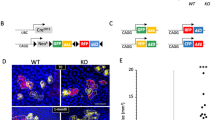Abstract
Snai1 (Snail) and Snai2 (Slug), the two main members of Snail family factors, are important mediators of epithelial-mesenchymal transitions and involved in tumor progression. We recently reported that Snai1 plays a major role in tumor growth, invasion and metastasis, but the contribution of Snai2 to tumorigenesis is not yet well understood. To approach this question we have silenced Snai2 and/or Snai1 by stable RNA interference in two independent mouse skin carcinoma (HaCa4 and CarB) cell lines. We demonstrate that Snai2 knockdown has a milder effect, but collaborates with Snai1 silencing in reduction of tumor growth potential of either carcinoma cell line when injected into nude mice. Importantly, Snai1 or Snai2 silencing dramatically influences the metastatic ability of squamous carcinoma HaCa4 cells, inducing a strong reduction in liver and lung distant metastasis. However, only Snai1 knockdown has an effective action on invasiveness and fully abolishes tumor cell dissemination into the spleen. These results demonstrate that Snai1 and Snai2 collaborate on primary tumor growth and specifically contribute to site-specific metastasis of HaCa4 cells. These data also indicate that Snai1 is the major regulator of local invasion, supporting a hierarchical participation of both factors in the metastatic process.
This is a preview of subscription content, access via your institution
Access options
Subscribe to this journal
Receive 50 print issues and online access
$259.00 per year
only $5.18 per issue
Buy this article
- Purchase on SpringerLink
- Instant access to full article PDF
Prices may be subject to local taxes which are calculated during checkout






Similar content being viewed by others
Abbreviations
- d.p.i.:
-
days post-injection
- EMT:
-
epithelial-mesenchymal transition
- MDCK:
-
Madin Darby canine kidney
- MMP:
-
metalloproteinase
- MRI:
-
magnetic resonance imaging
- qRT-PCR:
-
quantitative real-time PCR
- RT–PCR:
-
reverse transcription–PCR
- shRNA:
-
small hairpin interfering RNA
References
Barrallo-Gimeno A, Nieto MA . (2005). The Snail genes as inducers of cell movement and survival: implications in development and cancer. Development 132: 3151–3161.
Batlle E, Sancho E, Franci C, Dominguez D, Monfar M, Baulida J et al. (2000). The transcription factor snail is a repressor of E-cadherin gene expression in epithelial tumor cells. Nat Cell Biol 2: 84–89.
Birchmeier W, Behrens J . (1994). Cadherin expression in carcinomas: role in the formation of cell junctions and the prevention of invasiveness. Biochim Biophys Acta 1198: 11–26.
Bolos V, Peinado H, Perez-Moreno MA, Fraga MF, Esteller M, Cano A . (2003). The transcription factor Slug represses E-cadherin expression and induces epithelial to mesenchymal transitions: a comparison with Snail and E47 repressors. J Cell Sci 116: 499–511.
Cano A, Perez-Moreno MA, Rodrigo I, Locascio A, Blanco MJ, del Barrio MG et al. (2000). The transcription factor snail controls epithelial-mesenchymal transitions by repressing E-cadherin expression. Nat Cell Biol 2: 76–83.
Carver EA, Jiang R, Lan Y, Oram KF, Gridley T . (2001). The mouse snail gene encodes a key regulator of the epithelial-mesenchymal transition. Mol Cell Biol 21: 8184–8188.
Christofori G . (2006). New signals from the invasive front. Nature 441: 444–450.
Christofori G, Semb H . (1999). The role of the cell-adhesion molecule E-cadherin as a tumor-suppressor gene. Trends Biochem Sci 24: 73–76.
Come C, Magnino F, Bibeau F, De Santa Barbara P, Becker KF, Theillet C et al. (2006). Snail and slug play distinct roles during breast carcinoma progression. Clin Cancer Res 12: 5395–5402.
Elloul S, Elstrand MB, Nesland JM, Trope CG, Kvalheim G, Goldberg I et al. (2005). Snail, Slug, and Smad-interacting protein 1 as novel parameters of disease aggressiveness in metastatic ovarian and breast carcinoma. Cancer 103: 1631–1643.
Elloul S, Silins I, Trope CG, Benshushan A, Davidson B, Reich R . (2006). Expression of E-cadherin transcriptional regulators in ovarian carcinoma. Virchows Arch 449: 520–528.
Fraga MF, Herranz M, Espada J, Ballestar E, Paz MF, Ropero S et al. (2004). A mouse skin multistage carcinogenesis model reflects the aberrant DNA methylation patterns of human tumors. Cancer Res 64: 5227–5234.
Guaita S, Puig I, Franci C, Garrido M, Dominguez D, Batlle E et al. (2002). Snail induction of epithelial to mesenchymal transition in tumor cells is accompanied by MUC1 repression and ZEB1 expression. J Biol Chem 277: 39209–39216.
Gupta GP, Massague J . (2006). Cancer metastasis: building a framework. Cell 127: 679–695.
Hajra KM, Chen DY, Fearon ER . (2002). The SLUG zinc-finger protein represses E-cadherin in breast cancer. Cancer Res 62: 1613–1618.
Inoue A, Seidel MG, Wu W, Kamizono S, Ferrando AA, Bronson RT et al. (2002). Slug, a highly conserved zinc finger transcriptional repressor, protects hematopoietic progenitor cells from radiation-induced apoptosis in vivo. Cancer Cell 2: 279–288.
Jiang R, Lan Y, Norton CR, Sundberg JP, Gridley T . (1998). The Slug gene is not essential for mesoderm or neural crest development in mice. Dev Biol 198: 277–285.
Jorda M, Marazuela E, Vinyals A, Cubillo E, Olmeda D, Valero E et al. (2007). Id-1 is induced in MDCK epithelial cells by activated Erk/MAPK pathway in response to expression of the Snail and E47 transcription factors. Exp Cell Res 313: 2389–2403.
Jorda M, Olmeda D, Vinyals A, Valero E, Cubillo E, Llorens A et al. (2005). Upregulation of MMP-9 in MDCK epithelial cell line in response to expression of the Snail transcription factor. J Cell Sci 118: 3371–3385.
Kajita M, McClinic KN, Wade PA . (2004). Aberrant expression of the transcription factors snail and slug alters the response to genotoxic stress. Mol Cell Biol 24: 7559–7566.
Llorens A, Rodrigo I, Lopez-Barcons L, Gonzalez-Garrigues M, Lozano E, Vinyals A et al. (1998). Down-regulation of E-cadherin in mouse skin carcinoma cells enhances a migratory and invasive phenotype linked to matrix metalloproteinase-9 gelatinase expression. Lab Invest 78: 1131–1142.
Manzanares M, Locascio A, Nieto MA . (2001). The increasing complexity of the Snail gene superfamily in metazoan evolution. Trends Genet 17: 178–181.
Mehlen P, Puisieux A . (2006). Metastasis: a question of life or death. Nat Rev Cancer 6: 449–458.
Moreno-Bueno G, Rodríguez-Perales S, Sánchez-Estévez C, Hardisson D, Sarrió D, Prat J et al. (2003). Cyclin D1 gene (CCND1) mutations in endometrial cancer. Oncogene 22: 6115–6118.
Navarro P, Gomez M, Pizarro A, Gamallo C, Quintanilla M, Cano A . (1991). A role for the E-cadherin cell-cell adhesion molecule during tumor progression of mouse epidermal carcinogenesis. J Cell Biol 115: 517–533.
Nieto MA . (2002). The snail superfamily of zinc-finger transcription factors. Nat Rev Mol Cell Biol 3: 155–166.
Olmeda D, Jorda M, Peinado H, Fabra A, Cano A . (2007a). Snail silencing effectively suppresses tumor growth and invasiveness. Oncogene 26: 1862–1874.
Olmeda D, Moreno-Bueno G, Flores JM, Fabra A, Portillo F, Cano A . (2007b). SNAI1 is required for tumor growth and lymph node metastasis of human breast carcinoma MDA-MB-231 cells. Cancer Res 67: 11721–11731.
Peinado H, Iglesias-de la Cruz MC, Olmeda D, Csiszar K, Fong KS, Vega S et al. (2005). A molecular role for lysyl oxidase-like 2 enzyme in snail regulation and tumor progression. EMBO J 24: 3446–3458.
Peinado H, Olmeda D, Cano A . (2007). Snail, Zeb and bHLH factors in tumor progression: an alliance against the epithelial phenotype? Nat Rev Cancer 7: 415–428.
Perez-Losada J, Sanchez-Martin M, Perez-Caro M, Perez-Mancera PA, Sanchez-Garcia I . (2003). The radioresistance biological function of the SCF/kit signaling pathway is mediated by the zinc-finger transcription factor Slug. Oncogene 22: 4205–4211.
Rodrigo I, Cato AA, Cano A . (1999). Regulation of E-cadherin gene expression during tumor progression: the role of a new Ets-binding site and the E-pal element. Exp Cell Res 248: 358–371.
Savagner P, Kusewitt DF, Carver EA, Magnino F, Choi C, Gridley T et al. (2005). Developmental transcription factor slug is required for effective re-epithelialization by adult keratinocytes. J Cell Physiol 202: 858–866.
Thiery JP . (2002). Epithelial-mesenchymal transitions in tumor progression. Nat Rev Cancer 2: 442–454.
Acknowledgements
We thank Vanesa Santos for excellent technical assistance, P López for MRI analysis, H Clevers for the pTER-Zeo vector and H Peinado for critical reading of the article. This work was supported by grants from the Spanish Ministry of Education and Science (SAF2004-00361; SAF2007-63051; NAN2004-09230-C04-02; Consolider-Ingenio CSD00C-2007-26102) and the EU (MRTN-CT-2004-005428).
Author information
Authors and Affiliations
Corresponding author
Additional information
Supplementary Information accompanies the paper on the Oncogene website (http://www.nature.com/onc).
Rights and permissions
About this article
Cite this article
Olmeda, D., Montes, A., Moreno-Bueno, G. et al. Snai1 and Snai2 collaborate on tumor growth and metastasis properties of mouse skin carcinoma cell lines. Oncogene 27, 4690–4701 (2008). https://doi.org/10.1038/onc.2008.118
Received:
Revised:
Accepted:
Published:
Issue Date:
DOI: https://doi.org/10.1038/onc.2008.118
Keywords
This article is cited by
-
LncRNA ELF3-AS1 inhibits gastric cancer by forming a negative feedback loop with SNAI2 and regulates ELF3 mRNA stability via interacting with ILF2/ILF3 complex
Journal of Experimental & Clinical Cancer Research (2022)
-
Aberrant expression of Notch1/numb/snail signaling, an epithelial mesenchymal transition related pathway, in adenomyosis
Reproductive Biology and Endocrinology (2015)
-
Protein kinase CK2 in breast cancer: the CK2β regulatory subunit takes center stage in epithelial plasticity
Cellular and Molecular Life Sciences (2015)
-
Epidermal Snail expression drives skin cancer initiation and progression through enhanced cytoprotection, epidermal stem/progenitor cell expansion and enhanced metastatic potential
Cell Death & Differentiation (2014)
-
Oncogenic roles of EMT-inducing transcription factors
Nature Cell Biology (2014)



